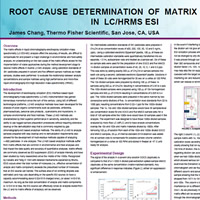
ROOT CAUSE DETERMINATION OF MATRIX EFFECTS IN LC/HRMS ESI James Chang, Ph.D. 355 River Oaks Parkway, San Jose, CA 95134 |
Resumo do Pôster:The matrix effects in liquid chromatography-electrospray ionization-mass spectrometry (LC-ESI-MS) analysis affect the accuracy of results, are difficult to compensate for and present a major challenge in environmental and food safety analysis. An understanding on the root cause of the matrix effects allows for the implementation of viable approaches during the method development stage to resolve matrix effects in routine LC-MS analysis. Using calibration standards of 381 pesticides prepared in solvent and five different sample matrices as model samples, studies were performed to evaluate the relationship between analyte concentrations and sample matrices using high performance and micro-flow liquid chromatography-ESI-high resolution mass spectrometry (HRMS); and the elution patterns of target compounds and matrix components under various chromatographic conditions. Results obtained from the principal component analysis and slope ratios of calibration curves provided quantitative measurements of the matrix effects. This study demonstrated that sample dilution is an effective approach to alleviate matrix effects for pesticides co-eluting with low concentration matrix components. Severe matrix effects, however, may still be observed for some pesticides in 1000x diluted samples should concentrations of these co-eluting matrix components are 50- to 100-fold higher than the corresponding/affected pesticides. Optimizing LC and MS parameters to ensure effective peak concentration of co-eluting pesticides and matrix components allows for the development of routine multi-residual method with minimal matrix effects. It is possible to replace routine cleanup procedure by a dilute-and-shoot approach for improved data quality and operational efficiency. The optimized method can be used as is or be transferred to an alternate LC-MS system for routine, quantitative multi-residue analysis free from matrix effects not only for pesticides, but for other organic contaminants such as veterinary drugs, mycotoxins, pharmaceuticals and personal care products in environmental and food sample matrices. |
